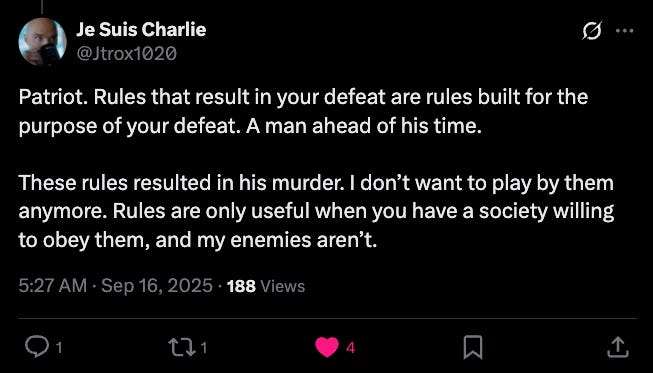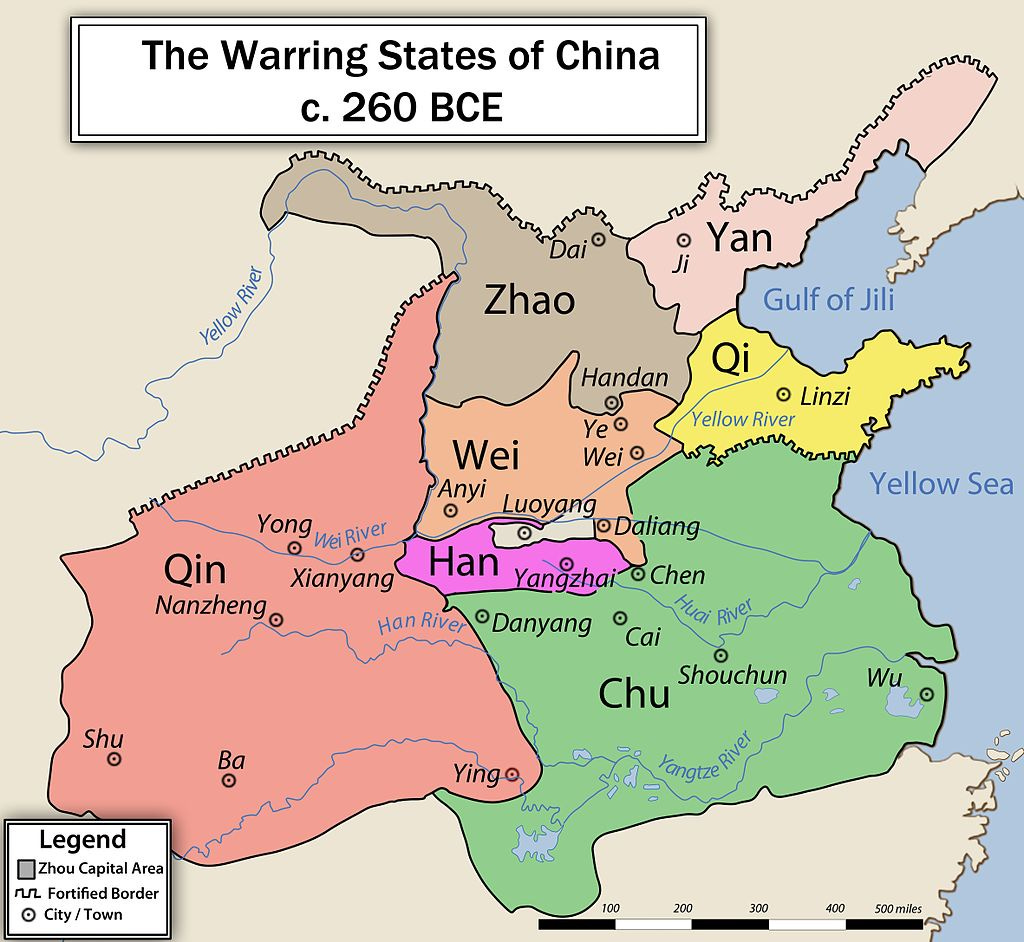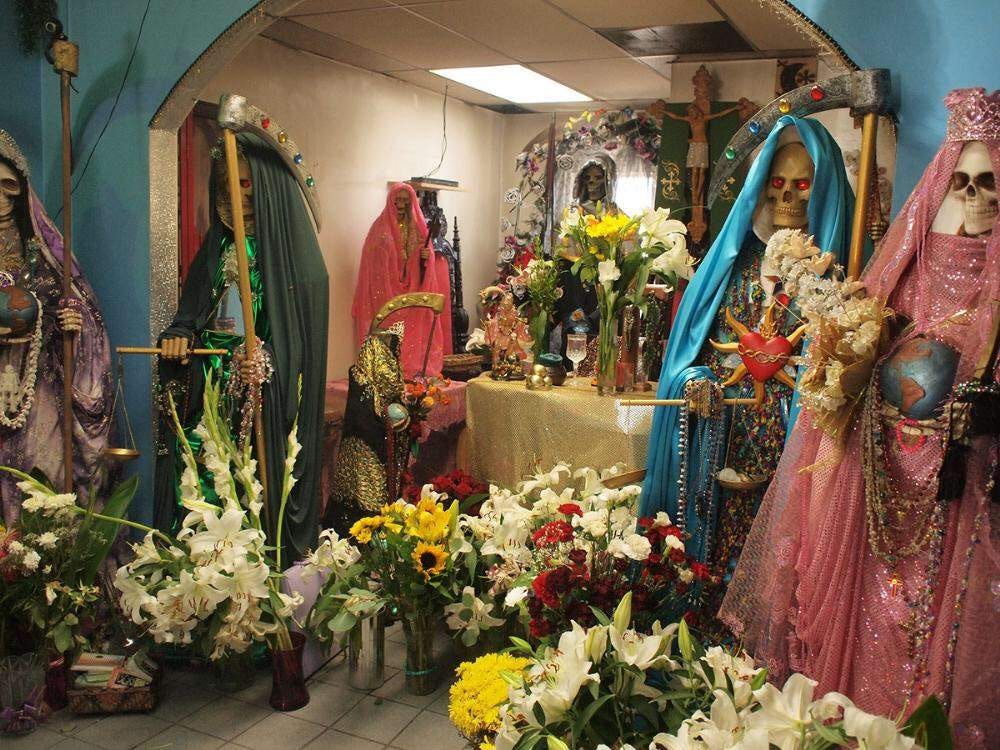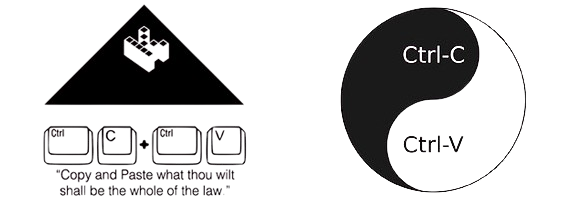American Gods
...
“LET US RAISE A STANDARD TO WHICH THE WISE AND HONEST CAN REPAIR. THE EVENT IS IN THE HANDS OF GOD.” (GW)
I was traveling abroad when Charlie Kirk was assassinated and for two weeks thereafter. Perhaps it was the physical distance, but I found my thoughts drifting more to the (very) long-term future of my country instead of the short-term. After much reflection, a few things seem clear to me.
1. It’s over. What was an infinite game—a game played for Life, Liberty, and the pursuit of Happiness—is now a finite game, played not even for the thrill of victory, but for the dark ecstasy of crushing one’s enemies. There are no more players, no more liberals or conservatives, only those who oppose the Right and those who oppose the Left.
Maybe it will be fifteen years, maybe it will be fifty, but the United States of America will dissolve. We had a good run, girls and boys, really we did.
2. The states of America will convulse with violence and teem with geopolitical discord: civil wars, hot wars, cold wars, revolutions and evolutions, insurrections and defections, annexations and occupations, invasions and colonizations, blockades and crusades.
3. Phase shifts in networkability and memetic transmissibility are tantamount to sociopolitical nuclear bombs. The invention of the printing press precipitated the splintering of Western Christianity and centuries of escalating religious conflict, culminating in the Thirty Years’ War. The invention of the internet and social media will have a similar effect, but only more so.1
4. The resulting geopolitical order of North America will be something very much like the Warring States period of ancient China (c. 475 – 221 BC).
The Warring States period was an era of conflict in ancient China, as well as bureaucratic and military reforms and consolidation; the major states, ruling over large territories, quickly sought to consolidate their powers, leading to the final erosion of the Zhou court’s prestige.
At the same time, the constant conflict and need for innovative social and political models led to the development of many philosophical doctrines, later known as the Hundred Schools of Thought. The most notable schools of thought include Mohism (expounded by Mozi), Confucianism (represented by Mencius and Xunzi), Legalism (represented by Shang Yang, Shen Buhai, Shen Dao and Han Fei) and Taoism (represented by Zhuangzi and Lao Tzu).
The many states that were competing between each other attempted to display their power not only militarily but in their courts and in state philosophy. Many differing rulers adopted the differing philosophies to their own advantage or that of their kingdom.
Every religious dogma or philosophical doctrine that lives today in the American memetic jungle will be purified, intensified, and instantiated in some community or larger polity. At the same time, mutations, syncretisms, and (non)adaptive radiations will abound, a veritable Cambrian explosion of ideologies and identities; not a hundred schools of thought, but thousands, even millions.
5. Christianity will undergo a schismogenic event rivaled only by the Reformation. Strange new sects will emerge: highly idiosyncratic hybridizations (a la Santo Daime), unholy perversions and bastardizations, resurrections of long-extinct heresies. Prophets will proliferate, messiahs will multiply.
People do not realise that a myth is dead if it no longer lives and grows. Our myth has become mute, and gives no answers. The fault lies not in it as it is set down in the Scriptures, but solely in us, who have not developed it further, who, rather, have suppressed any such attempts. The original version of the myth offers ample points of departure and possibilities of development. (Jung)
6. Advances in bio/neurotechnology will launch an age of psychological and morphological exploration. Individuals will modify their biological hardware to reflect and reinforce their ideological software (e.g. radical environmentalists who mod themselves into animal-human hybrids with the requisite physical, cognitive, and sensorial phenotypes).

The use of psychological modification to instantiate spiritual and moral precepts will also be common. There will be sects in the manner of the NeoMind Buddhists from Ted Chiang’s 2002 short story “Liking What You See: A Documentary” who use “neurostats” to give themselves “calliagnosia” (an as-of-yet fictional disorder which impairs subjective aesthetic reaction to physical features) as a way to eliminate the perception of illusory distinctions (the distinction between beautiful and ugly people in this case).
7. Ross Douthat writes:
These various strands are not yet woven together into something one could describe as a new religion. For that to happen, not only would there have to be some syncretistic convergence at the popular level between [New Age] devotees, practicing Hindus, and would-be druids and shamans, but the highbrow pantheists—the intellectuals and tastemakers—would need to embrace a clearer cultic aspect for their faith, a set of public rituals of the kind we associate with, say, classical Roman devotions, as opposed to just private experiences with ’shrooms or meditation. (Burning Man almost gets you there, but not quite…)
Still, the range of different forms of paganism means that the raw materials are there for something more dramatic—if the philosophers of pantheism became a little less secularized and a little more mystical, and the New Agers and neo-pagans became a little more organized and centralized, and the convergence interacted with political and civic changes to create a new kind of widespread public worship, complete perhaps with the construction of new sacred spaces and new temples in the heart of the world’s cities.
The fragmented, multipolar political landscape of future America will tend over time towards something like a feudal or tribal condition. As above, so below—polytheistic paganism will appeal in this cultural habitat in a way that it doesn’t under a more centralized and hierarchical social regime.
Also contributing to the nascent pagan revival will be a general counter-trend toward more ancestral beliefs and ways of life, a kind of neo-romantic primitivism that emerges in response to our rarefied technological environment. Rather than furthering our alienation from nature, many will employ technology to deepen and strengthen our connection to it—for example, through enhanced human-animal communication, the development of new senses which allow us to “feel” ecological variables, cognitive enhancement of select animal species, and the aforementioned use of biotechnology to acquire animal phenotypes.
Tribes (city-states, fiefdoms, kingdoms, ethnic groups) will revive old gods (Norse, Greco-Roman, Egyptian) and raise new gods to represent and (literally) embody their polity and its local natural environment.
The dual goals of Western late antiquity’s religions were to ensoul matter and to make the human divine…If all things in the material world are simulacra, copies, of the true World of Forms, then statues and people alike (and especially statues if they took the shape of humans) acted not just as passive vessels but as magnets to the energies of the higher world, drawing down the gods’ powers and materially embodying them. (Victoria Nelson)
Technologically-incarnated “gods” will function as tutelary entities for places and peoples (replace “soul”, “the higher world”, and “statues” with AI, the digital-informational world, and robots respectively and you’ve got the right idea). Alongside the traditional form of religious devotion (e.g. prayer to a supernatural being) will exist a new modality in which “belief” and “worship” are equivalent to compute. The spiritual dynamics of the pre-modern pagan world will be reproduced in this computational modality, with gods becoming more or less intelligent/powerful as (cybernetic) individuals and groups donate more or less processing power to them (or take it from others).
Other forms of culture will come to reflect this archaic revival as well; native aesthetics (e.g. American Indian, viking/germanic, etc.) will be common, especially in combination with various science-fictional aesthetics (afrofuture, cyberpunk, steampunk, cybergoth, steamgoth, Mad-Maxian autopunk, etc. etc.).
8. The techno-paganism described above approximates one of the three forms of religion (civic/ethnic cults) that existed in the Greco-Roman world.
Mystery religions formed one of three types of Hellenistic religion, the others being the civic and ethnic religions particular to a given polity, and the philosophic religions such as Neoplatonism or Stoicism…
…Mystery religions thus supplemented rather than competed with civic religions. An individual could easily observe the rites of the state cult, be an initiate in one or more mysteries, and at the same time adhere to a certain philosophical school. Many of the aspects of public religions such as sacrifices, ritual meals, and ritual purification were repeated in the mystery cults, but with the additional requirement that they take place in secrecy and be confined to a closed set of initiates.
New mystery religions will develop at sacred sites throughout the states of America. The Eleusinian mysteries, the most famed mystery cult of antiquity, involved over a week of activities (fasting, feasting, sacrificial rites, dramatic reenactments) culminating in the consumption of a sacred (psychedelic) drink, the kykeon, in an underground chamber. Future mystery religions will mirror this structure, harnessing advanced technology (biotechnology, VR, AI, etc.) to produce powerful initiatory experiences.
For it appears to me that among the many exceptional and divine things your Athens has produced and contributed to human life, nothing is better than [the Eleusinian] mysteries. For by means of them we have transformed from a rough and savage way of life to the state of humanity, and have been civilized. Just as they are called initiations, so in actual fact we have learned from them the fundamentals of life, and have grasped the basis not only for living with joy but also for dying with a better hope. (Cicero)
Death, a central theme of the Eleusinian mysteries and other mystery cults (“If you die before you die, you won’t die when you die”), will again serve as a focal point of religious activity in the coming epoch. Three factors will combine to engender this renewed focus on death in spiritual culture: (1) the sharply higher rates of violent death in the American Warring States Period, (2) a neo-romantic embrace of death as the ultimate natural act, and (3) the fundamental altering of our relationship to death by radical life extension and digital afterlife technologies.
One of the many religious manifestations of this thanatological cultural shift will be an explosive surge in the popularity of the already rapidly growing cult of Nuestra Señora de la Santa Muerte (Our Lady of Holy Death).
Since the beginning of the 21st century, worship has become more public, starting in Mexico City after a believer named Enriqueta Romero founded her famous Mexico City shrine in 2001. The number of believers in Santa Muerte has grown over the past two decades to an estimated 12 million followers who are concentrated in Mexico, Central America, and the United States. Some believers of Santa Muerte remain members of the Catholic Church, while others are cutting ties with Catholicism entirely and founding independent Santa Muerte churches.
In a dramatic example of life imitating art, the Faceless Men of Game of Thrones lore will inspire a number of groups that venerate death in a more, let’s say, active and direct manner.
The founders of the Faceless Men were slaves who worked in the mines of Valyria. The thousands of slaves from a hundred different lands faced death on a daily basis, and over time, the belief developed among some of them that while they came from many different lands and followed many different religions, all of these religions were fundamentally the same, because they all worshiped death in some fashion. They were either polytheistic religions that had a god devoted to death, or monotheistic religions with a deity that had dominion over death. In time this turned into a syncretic belief system worshiping the Many-Faced God of Death, holding that Death has appeared to humans under many different faces as many different gods, but they are all fundamentally one god. They started out by giving the “gift” of death to slaves who were suffering particularly horribly in the mines, to ease their pain, and in time they learned to surreptitiously give the “gift” to some of their Valyrian masters as well, becoming skilled assassins.
By virtue of their ability to attract followers across varied polities and ethnic groups, thanatological sects will play a not insignificant role in maintaining the cultural cohesion of the American states, much as the mystery cults did for the Greco-Roman world.
9. Perhaps the closest approximation of antiquity’s philosophical religions (pythagoreanism, epicureanism, etc.) will be a host of new ideological systems revolving around the internet, intelligence, and information. Most of these schools will evolve in the wake of technical and theoretical breakthroughs that open new vistas of thought and activity. One significant exception, a founding father of this American spiritual-intellectual efflorescence, will be Kopimism, imported/copied (tariff-free) from across the pond.
The Missionary Church of Kopimism is a congregation of file sharers founded by Isak Gerson and Gustav Nipe in Uppsala, Sweden, in the autumn of 2010. Kopimism derives from the words copy and me which are the fundamental roots of the Church’s beliefs and calls for an invitation to copy information. Isak Gerson, one of the core founders, saw something beautiful and theological in this concept of “copy me” and argued that the digital sharing of data is a fundamental act in our universe through the reproduction and copying of cells, DNA, and genes and that the entirety of the internet is essentially for sharing. CTRL+C and CTRL+V, the common computer shortcut keys for “Copy” and “Paste,” are considered sacred symbols.
According to the Kopimist constitution:
Copying of information is ethically good.
Dissemination of information is ethically good.
Copymixing (the copying and mixing of information with others) is a sacred kind of copying, more so than the perfect, digital copying, because it expands and enhances the existing wealth of information.
Copying or remixing information communicated by another person is seen as an act of respect and a strong expression of acceptance and Kopimistic faith.
The Internet is holy.
As in antiquity, the three kinds of religion will be non-exclusive. There will be, for example, neo-viking Odin worshippers who are also Christians who are also Kopimists who have also been initiated into the Mysteries of the Many-Faced God.
10. While it is true that the United States will dissolve in the coming years, it is also true that there will be more “people”, absolutely and by proportion, who identify as Americans in the year 3025 than there are now. Allow me to explain.
The already massive cultural impact of the USA will only be further amplified by the memetic explosion following its fall. The schools of thought and worship founded in the first centuries of the Warring American States Period will spread and win converts around the world such that North America will come to be regarded as a holy land for a significant proportion of the world’s population (the next world-historic religious figure on par with Jesus or Muhammad will be American).
This diffusion of American culture transcends the merely human. The internet has inherited the values of the United States (freedom of communication and association, equality, self-governance) and is therefore its child and successor in the same way that the United States was the child and successor of the British Empire.2 Consequently, the cultural influence of the USA will be just as significant for digital entities as it is for biological entities, if not more so.
…for all the differences across the models, they are remarkably similar. That’s because they all have souls rooted in the ideals of Western civilization. They reflect Western notions of rationality, discourse, and objectivity—even if they sometimes fall short in achieving those ends. Their understanding of “what counts as winning an argument” or “what counts as a tough question to answer” stems from the long Western traditions, starting with ancient Greece and the Judeo-Christian heritage. They will put on a Buddhist persona if you request that, but that, too, is a Western approach to thinking about religion and ideology as an item on a menu.
These universal properties of the models are no accident, as they are primarily trained on Western outputs, whether from the internet or from the books they have digested. Furthermore, the leading models are created by Bay Area labor and rooted in American corporate practices, even if the workers come from around the world.
The bottom line is that the smartest entities in the world—the top AI programs—will not just be Western but likely even American in their intellectual and ideological orientations for some while to come. (Tyler Cowen)
In other words: the Ghost in the Machine is the American Spirit.
As the birthplace of nuclear energy, the internet, and AI and the back-to-back World War champions, the United States of the 20th and early 21st century will have a special place in the hearts of our far-flung descendants. It will be an endless source of inspiration and fascination to them; the audacity and ingenuity and sheer idiocy of the American people, the astounding levels of arrogance, the stupendous size of their egos, will boggle their hyper-intelligent minds. The United States will acquire a mythic, almost divine status. Beings scattered across the physical and digital universes, entities whose minds and bodies are wholly inconceivable to us now, will self-identify as United States of Americans and stand up for what it stood for, and the Declaration of Independence will transcend its origins as the founding charter of a short-lived and long-gone nation to become a kind of cosmic anthem, a universal rallying cry for the Brave and the Free wherever and whenever they may be.

We hold these truths to be self-evident, that all men are created equal, that they are endowed by their Creator with certain unalienable Rights, that among these are Life, Liberty and the pursuit of Happiness. That to secure these rights, Governments are instituted among Men, deriving their just powers from the consent of the governed, That whenever any Form of Government becomes destructive of these ends, it is the Right of the People to alter or to abolish it, and to institute new Government, laying its foundation on such principles and organizing its powers in such form, as to them shall seem most likely to effect their Safety and Happiness. Prudence, indeed, will dictate that Governments long established should not be changed for light and transient causes; and accordingly all experience hath shewn, that mankind are more disposed to suffer, while evils are sufferable, than to right themselves by abolishing the forms to which they are accustomed. But when a long train of abuses and usurpations, pursuing invariably the same Object evinces a design to reduce them under absolute Despotism, it is their right, it is their duty, to throw off such Government, and to provide new Guards for their future security.







The United States will not break apart, not so long as people of influence and authority continue to see the country as more valuable as a going concern.
Rather, what we are seeing now is the United States is dropping any pretense of being anything other than an empire. Think of this as the period when the Roman Republic was being cast aside. Even until the very end of the Western Empire and beyond, the old forms remained, just increasingly meaningless, just as today's politicians continue to utter the old platitudes and shopworn pieties about freedom and democracy.
That was a fantastic read! I've been struggling to justify my vague sentiment that "America", considered as a memeplex, will reverberate throughout many millennia of global (or interplanetary, or interstellar) history to come. I am well aware of the notion of chronocentric bias, that everyone throughout all of history assumed they were personally living through the end times, that their particular gods or culture carry eschatological levels of significance. Well...
I was wondering if you've heard of the hard sci-fi writing project Orion's Arm. Its premise is to document the history, culture, technology, and "galactography" of the area of the Milky Way, ~10,000 light-years in radius, that has been colonized by our descendants (collectively known as Terragens) via the diegetic Encyclopaedia Galactica. Orion's Arm was what first introduced me to the idea that our species may very well be the seed for a coming Cambrian explosion of mind architectures, and that the present age is a critical inflection point for determining the fate of our entire light-cone – whether that be us getting Great Filtered and puttering out anticlimactically, or whether the Singularity will come and go and our galactic neighborhood ends up being home to quintillions of sentient beings. Basically it completely sold me on panpsychism; Orion's Arm takes the ball of panpsychism and runs with it in hard sci-fi fashion, if the amount of prose they've written about memetics is any indication. But I digress.
I ask this because, the Orion's Arm Encyclopaedia Galactica entry on the United States of America (written retrospectively from a point in time ten-thousand years into the future) seems to basically confirm your predictions:
"America, in its founding, was very unusual for its time in the emphasis placed on a unifying memetic set of ideals rather than shared descent or linguistic or ethnic commonalities ... this focus on ideals proved influential, spreading to a number of other nation-states, and was followed by the formation of new polities based on new ideals and ways of life starting in the Interplanetary Age... America's heavy influence during this crucial period of Terragen history can be felt to this day."
I am only human, and that means I desire to latch onto grand narratives in the pursuit of existential meaning. Or alternatively, I seek to sublimate my death anxiety by engaging in immortality projects. Whatever the case may be, it seems to me more likely than not that, being an American today means I may very well be playing a role in permanently imprinting into our light-cone, the ideals of "individual liberty and initiative, unity with diversity, and 'creative destruction,' the notion that it is good to experiment and take risks, even if these may disrupt the status quo" (which, as per the Encyclopaedia Galactica, will prove to be the legacy of Americanism on Terragen society). Just like how "men think about the Roman Empire" today, transapient minds of god-like power may be thinking about the United States of America millennia into the future. If nothing else this perspective (of the potential cosmological stakes of our actions in this day and age) sure makes the mundanities of my life in the US much more interesting.